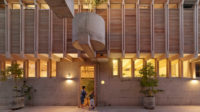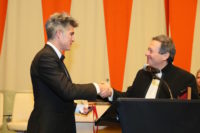Emerging Nations Grab Limelight at Awards Festival
Architects & Firms
In 2008, the festival’s first year, only four of the 17 category winners came from the developing world—hailing from China, Burkina Faso, Croatia, and Chile. This year, eight of the 15 winners in the categories for built work and five of the 10 for future projects came from nations with developing economies. These countries were: China (two winners), Mexico (two), Croatia (two), India, Thailand, South Africa, Brazil, Hungary, Dominica, Singapore, and Dubai. The organizer of the event, EMAP, which is the parent company of Architectural Review, changed some of the categories and added future projects for the 2009 festival.
Mapungubwe Interpretation Centre in South Africa by Peter Rich Architects. It also won in the “Built Projects: Culture” category. Click on the slide show icon to see more winners.
The World Building of the Year, the grand prize winner, also came from the developing world. Members of a “super-jury” (including Rafael Viñoly, Peter Cook, Will Alsop, and Kengo Kuma) selected the Mapungubwe Interpretation Centre in South Africa by Peter Rich Architects for the top honor, citing the way the building connects with the landscape and engages the local community. The thin-shell, rough-masonry complex houses artifacts from the region’s prehistory and was built with local labor. “It represents a complete contrast to last year’s winner,” notes Paul Finch, the WAF program director, referring to the Universita Luigi Bocconi in Milan by Grafton Architects. While last year’s top building impressed judges with its formal precision and sensitive insertion in a dense urban context, the Mapungubwe Centre’s appeal came from its rugged response to its natural setting. “The emotional punch of this design turned out to be unstoppable,” says Finch. “Whether this reflects a larger change in the architectural landscape, we’ll have to wait until next year to see.”
Held in November, the WAF attracted over 1,500 attendees, down a couple of hundred from last year, and drew 620 project entries, down about 15 percent, says Finch. “We were really pleased, considering the economic situation,” he notes. The festival, which took place for the second time in Barcelona, exhibited all of the submitted projects in a large gallery; presented talks by figures such as Viñoly, Farshid Moussavi of Foreign Office Architects, and Charles Jencks; and ran seminars on topics like Managing Explosive Urban Growth, Barcelona Now, and Preserving Heritage. “Less Does More” served as a theme running through the festival and the topic for an exhibition. Architects for the roughly 220 short-listed projects made 10-minute presentations, providing a live component to the competition.
World Building of the Year
- Mapungubwe Interpretation Centre in South Africa by Peter Rich Architects
Future Project of the Year
- The Spanish Pavilion at the 2010 Shanghai World Expo by Miralles Tagliabue EMBT
Interiors and Fit Out of the Year
- Corian Super-Surfaces Showroom in Italy by Amanda Levete Architects
Structural Design of the Year
- Arena Zagreb in Croatia by Upi-2m
Built Projects, Winners
- Civic and Community: Emergency Terminal in Croatia by Produkcija 004
- Culture: Mapungubwe Interpretation Centre in South Africa by Peter Rich
- Display: Cages for Macaws in Spain by Battle & Roig Architects
- Health: Teleton Tampico in Mexico by Sordo Madaleno Arquitectos
- Holiday: Restaurant Tusen in Sweden by Murman Arkitekter
- House: Klein Bottle House in Australia by McBride Charles Ryan
- Housing: The Met in Thailand by WOHA
- Landscape: Adaptation Palettes in China by Turen Design Institute
- Learning: The Pearl Academy of Fashion in India by Morphogenesis
- New and Old: TKTS Booth and the Redevelopment of Father Duffy Square in the U.S. by Perkins Eastman, Choi Ropiha, William Fellows/PKSB, and Dewhurst MacFarlane
- Office: Unileverhaus in Germany by Behnisch Architekten
- Production, Energy and Recycling: Bodegas Protos Winery in Spain by Rogers Stirk Harbour
- Shopping: Havaianas in Brazil by Isay Weinfeld
- Sport: Berry Sports Hall in Australia by Allen Jack + Cottier
- Transport: Bras Basah Mass Rapid Transit Station in Singapore by WOHA
Future Projects, Winners
- Commercial: Statoil Hydro Office in Norway by a-lab
- Cultural: Szentendre Cemetery in Hungary by A4 Studio, Spanish Pavilion in China by Miralles Tagliabue EMBT
- Education: Malama Learning Center in the U.S. by Eight Inc.
- Health: Al Jalila Children’s Specialty Hospital in Dubai
- Infrastructure: Aguascalientes City Suburban Train in Mexico by RVDG Arquitectura
- Landscape: London Green Grid in the U.K. by Design for London
- Residential: Mero Beach Project in Dominica by BURO II




